Integrated Geotechnical and Electrical Resistivity Tomography to Map the Lithological Variability Involved and Breaking Surface Evolution in Landslide Context: A Case Study of the Targa Ouzemour (Béjaia)
Abstract
1. Introduction
2. Description of the Study Area
3. Materials and Methods
4. Results and Discussion
4.1. Deformation Characteristics of the Landslide
4.2. Rainfall and Ground Water Effect
4.3. Landslide Structure and Mechanism Analysis
4.3.1. Geotechnical Characteristics Interpretation
4.3.2. Interpretation of Electrical Resistivity Tomography (ERT) Data
5. Conclusions
Author Contributions
Funding
Data Availability Statement
Acknowledgments
Conflicts of Interest
References
- Dikau, R.; Brunsden, D.; Schrott, L.; Ibsen, M.-L. Landslide Recognition: Identification, Movement and Causes; John Wiley and Sons: Chichester, UK, 1996; 251p. [Google Scholar]
- Varnes, D.J. Slope Movement Types and Processes. In Landslides, Analysis and Control, Transportation Research Board, Special Report No. 176; Schuster, R.L., Krizek, R.J., Eds.; National Academy of Sciences: Washington, DC, USA, 1978; pp. 11–33. [Google Scholar]
- Dikau, R. Mass-movement causes: Water. In Treatise on Geomorphology. Vol. 7, Mountain and Hillslope Geomorphology; Shroder, J., Marston, R.A., Stoffel, M., Eds.; Academic Press: San Diego, CA, USA, 2013; pp. 207–211. [Google Scholar]
- Cruden, D.M.A. A simple definition of a landslide. Bull. Eng. Geol. Environ. 1991, 43, 27–29. [Google Scholar] [CrossRef]
- Durville, J.L.; Sève, G. Stabilité des pentes-Glissements en terrain meuble. Tech. De L’ingénieur 1996, 1, C254-1. [Google Scholar] [CrossRef]
- Mugagga, F.; Kakembo, V.; Buyinza, M. A characterisation of the physical properties of soil and the implications for landslide occurrence on the slopes of Mount Elgon, Eastern Uganda. Nat. Hazards 2012, 60, 1113–1131. [Google Scholar] [CrossRef]
- Picarelli, L.; Urciuoli, G.; Russo, C. Effect of groundwater regime on the behaviour of clayed slopes. Can. Geotech. J. 2004, 41, 467–484. [Google Scholar] [CrossRef]
- Tuleushev, A.Z.; Harrison, F.E.; Kozlovskiy, A.L.; Zdorovets, M.V. Evolution of the absorption edge of PET films irradiated with Kr ions after thermal annealing and ageing. Opt. Mater. 2021, 119, 111348. [Google Scholar] [CrossRef]
- Darwish, M.A.; Zubar, T.I.; Kanafyev, O.D.; Zhou, D.; Trukhanova, E.L.; Trukhanov, S.V.; Trukhanov, A.V.; Henaish, A.M. Combined effect of microstructure, surface energy, and adhesion force on the friction of PVA/ferrite spinel nanocomposites. Nanomaterials 2022, 12, 1998. [Google Scholar] [CrossRef]
- Sassa, K. Landslide science as a new scientific discipline. In Progress in Landslide Science; Sassa, K., Fukuoka, H., Wang, F., Wang, G., Eds.; Springer: Berlin/Heidelberg, Germany, 2007. [Google Scholar]
- Hallal, N.; Yelles Chaouche, A.; Hamai, L.; Lamali, A.; Dubois, L.; Mohammedi, Y.; Hamidatou, M.; Djadia, L.; Abtout, A. Spatiotemporal evolution of the El Biar landslide (Algiers): New field observation data constrained by ground-penetrating radar investigations. Bull. Eng. Geol. Environ. 2019, 78, 5653–5670. [Google Scholar] [CrossRef]
- Hack, R. Geophysics for slope stability. Surv. Geophys. 2000, 21, 423–448. [Google Scholar] [CrossRef]
- Jongmans, D.; Garambois, S. Geophysical investigation of landslides: A review. Bulletin Société Géologique de France. BSGF Earth Sci. Bull. 2007, 178, 101–112. [Google Scholar] [CrossRef]
- Pasierb, B.; Grodecki, M.; Gwóźdź, R. Geophysical and geotechnical approach to a landslide stability assessment: A case study. Acta Geophys. 2019, 67, 1823–1834. [Google Scholar] [CrossRef]
- Lapenna, V.; Lorenzo, P.; Perrone, A.; Piscitelli, S.; Rizzo, E.; Sdao, F. 2D electrical resistivity imaging of some complex landslides in Lucanian Apennine chain, southern Italy. Geophysics 2005, 70, B11–B18. [Google Scholar] [CrossRef]
- Solberg, I.L.; Long, M.; Baranwal, V.C.; Gylland, A.S.; Rønning, J.S. Geophysical and geotechnical studies of geology and sediment properties at a quick-clay landslide site at Esp, Trondheim, Norway. Eng. Geol. 2016, 208, 214–230. [Google Scholar] [CrossRef]
- Bellanova, J.; Calamita, G.; Giocoli, A.; Luongo, R.; Macchiato, M.; Perrone, A.; Uhlemann, S.; Piscitelli, S. Electrical resistivity imaging for the characterization of the Montaguto landslide (southern Italy). Eng. Geol. 2018, 243, 272–281. [Google Scholar] [CrossRef]
- Whiteley, J.S.; Chambers, J.E.; Uhlemann, S.; Wilkinson, P.B.; Kendall, J.M. Geophysical monitoring of moisture-induced landslides: A review. Rev. Geophys. 2019, 57, 106–145. [Google Scholar] [CrossRef]
- Lapenna, V.; Perrone, A. Time-Lapse Electrical Resistivity Tomography (TL-ERT) for Landslide Monitoring: Recent Advances and Future Directions. Appl. Sci. 2022, 12, 1425. [Google Scholar] [CrossRef]
- Machane, D.; Bouhadad, Y.; Cheikh Lounis, G.; Chatelain, J.L.; Oubaiche, E.H.; Abbes, K.; Guillier, B.; Bensalem, R. Examples of geomorphologic and geological hazards in Algeria. Nat. Hazards 2008, 45, 295–308. [Google Scholar] [CrossRef]
- Hallal, N.; Dubois, L.; Bougdal, R.; Djouder, F. Instabilités gravitaires dans la région de Béjaïa (Algérie): Inventaire et appréciation de l’importance relative des différents paramètres conduisant au déclenchement, au maintien ou à l’activation des instabilités. Bull. Eng. Geol. Environ. 2018, 77, 631–645. [Google Scholar] [CrossRef]
- Hallal, N.; Bougdal, R.; Bensafia, W. Dédoublement du tunnel d’Aokas (BEJAIA): Geologie et caractérisation géotechnique du massif traversé. Stabilité de l’ouvrage. Bull. Eng. Geol. Environ. 2013, 72, 477–483. [Google Scholar] [CrossRef]
- Durand-Delga, M. Les unités à Mésozoïque métamorphique d’El Milia à Texenna (Algérie) et leur cadre structural. Bull. Société Géologique Fr. 1971, 7, 328–337. [Google Scholar] [CrossRef]
- Vila, J.M. La Chaîne Alpine d’Algérie Orientale et des Confins Algéro-Tunisiens. Ph.D. Thesis, Université Paris VI, Paris, France, 1980; 665p. [Google Scholar]
- Obert, D. Revue de Géologie Dynamique et de Géographie Physique; Masson: Issy-les-Moulineaux, France, 1984; Volume 1984, pp. 99–117. [Google Scholar]
- Leikine, M. Etude Géologique des Babors Occidentaux (Algérie). Ph.D. Thesis, Université de Paris, Paris, France, 1971; 536p. [Google Scholar]
- Hassissene, M. Etude Géologique du Djebel Arbalou-Gouraya: Éléments Occidentaux Du Domaine des Babors (Région de Béjaïa). Ph.D. Thesis, USTHB, Alger, Algérie, 1989; 96p. [Google Scholar]
- Glaçon, J. Recherches sur la géologie et les gîtes métallifères du Tell sétifien (Algérie). Bull. Du Serv. Géol. D’algérie Nouv. Sér. 1967, 32, 674. [Google Scholar]
- Glaçon, J. Le Gisement de Cavallo (El Aouana); Algérie, Bull, BRGM, 2, Section II, 6; Alger, Algérie, 1971; pp. 69–78. [Google Scholar]
- Fell, R.; Corominas, J.; Bonnard, C.; Cascini, L.; Leroi, E.; Savage, W.Z. Guidelines for landslide susceptibility, hazard and risk zoning for land use planning. Eng. Geol. 2008, 102, 85–98. [Google Scholar] [CrossRef]
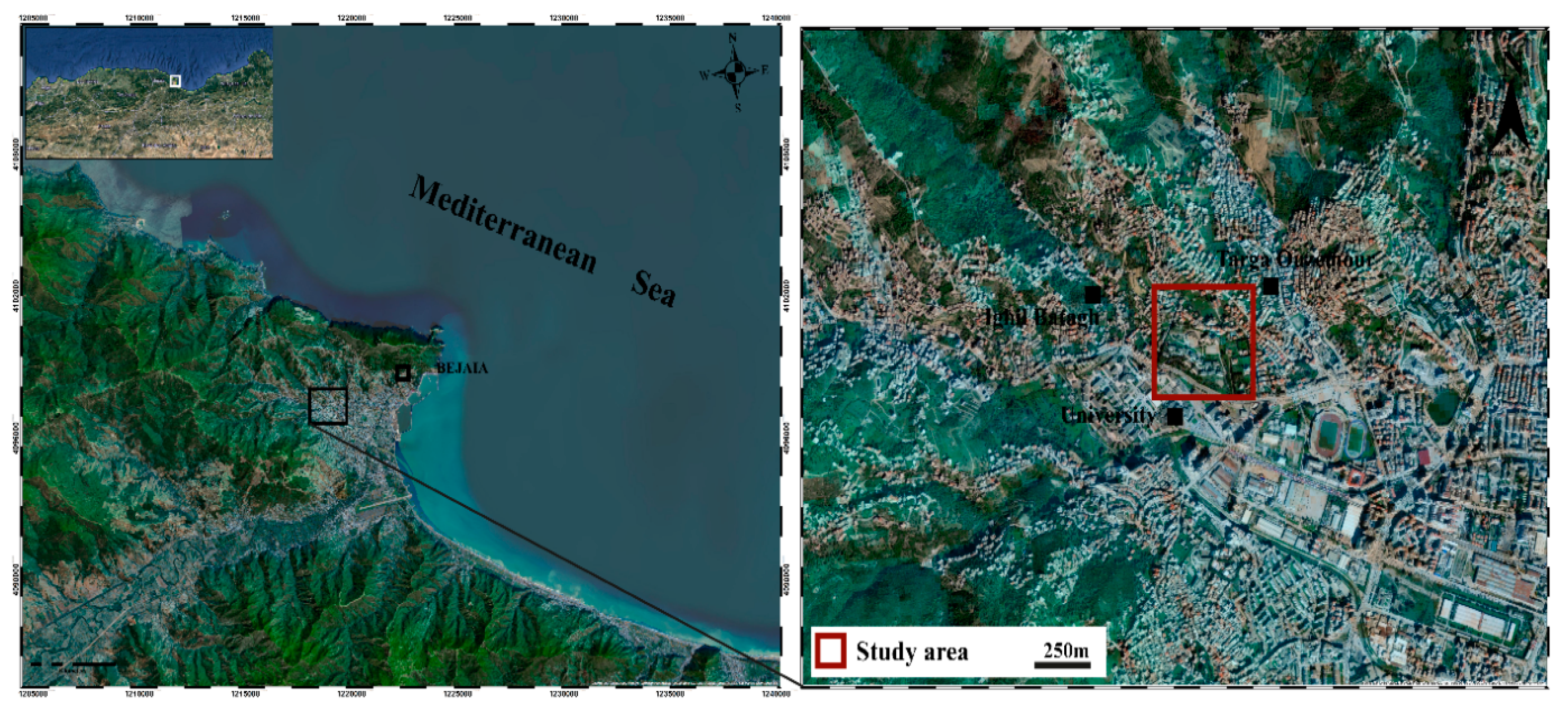
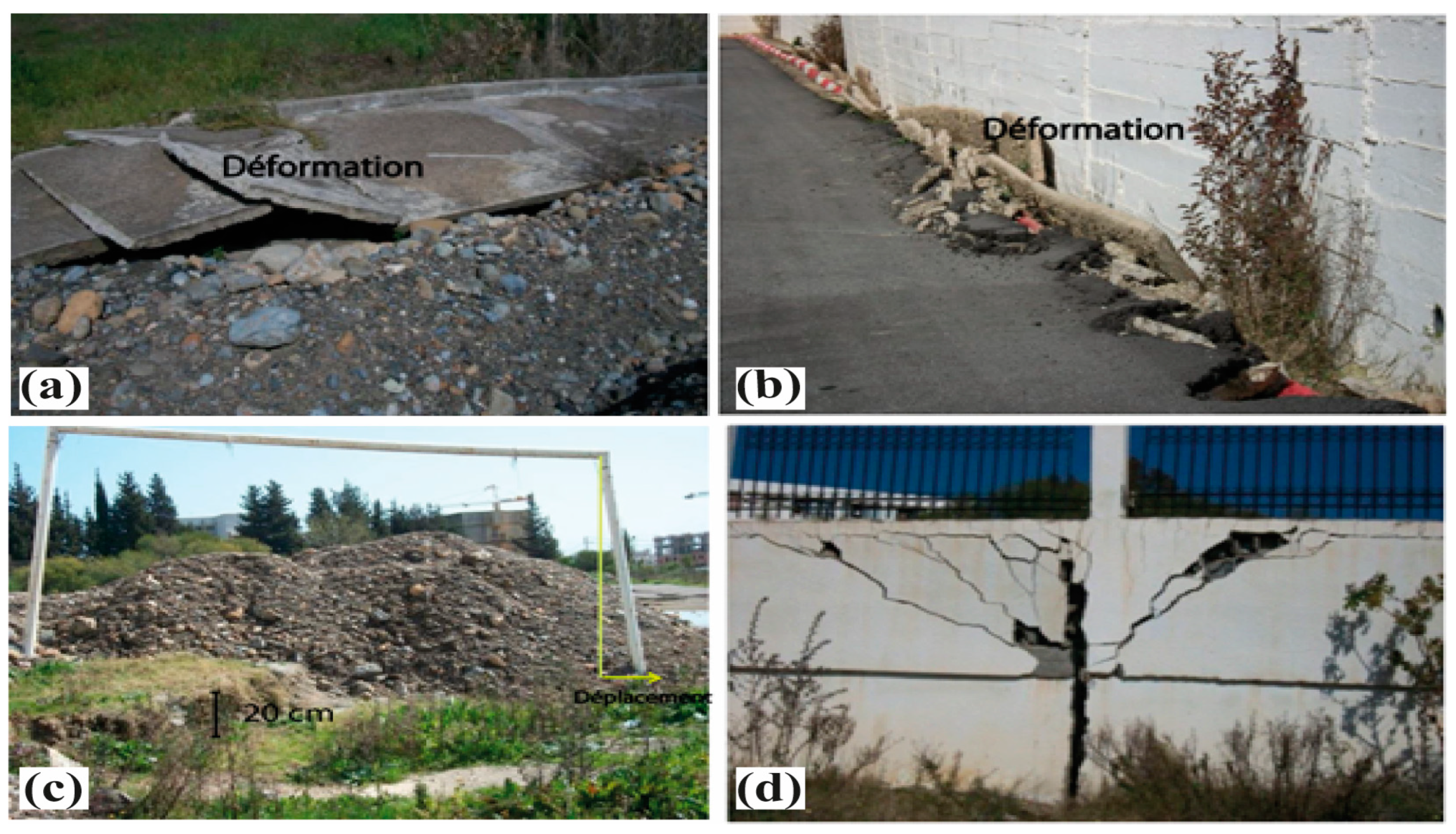

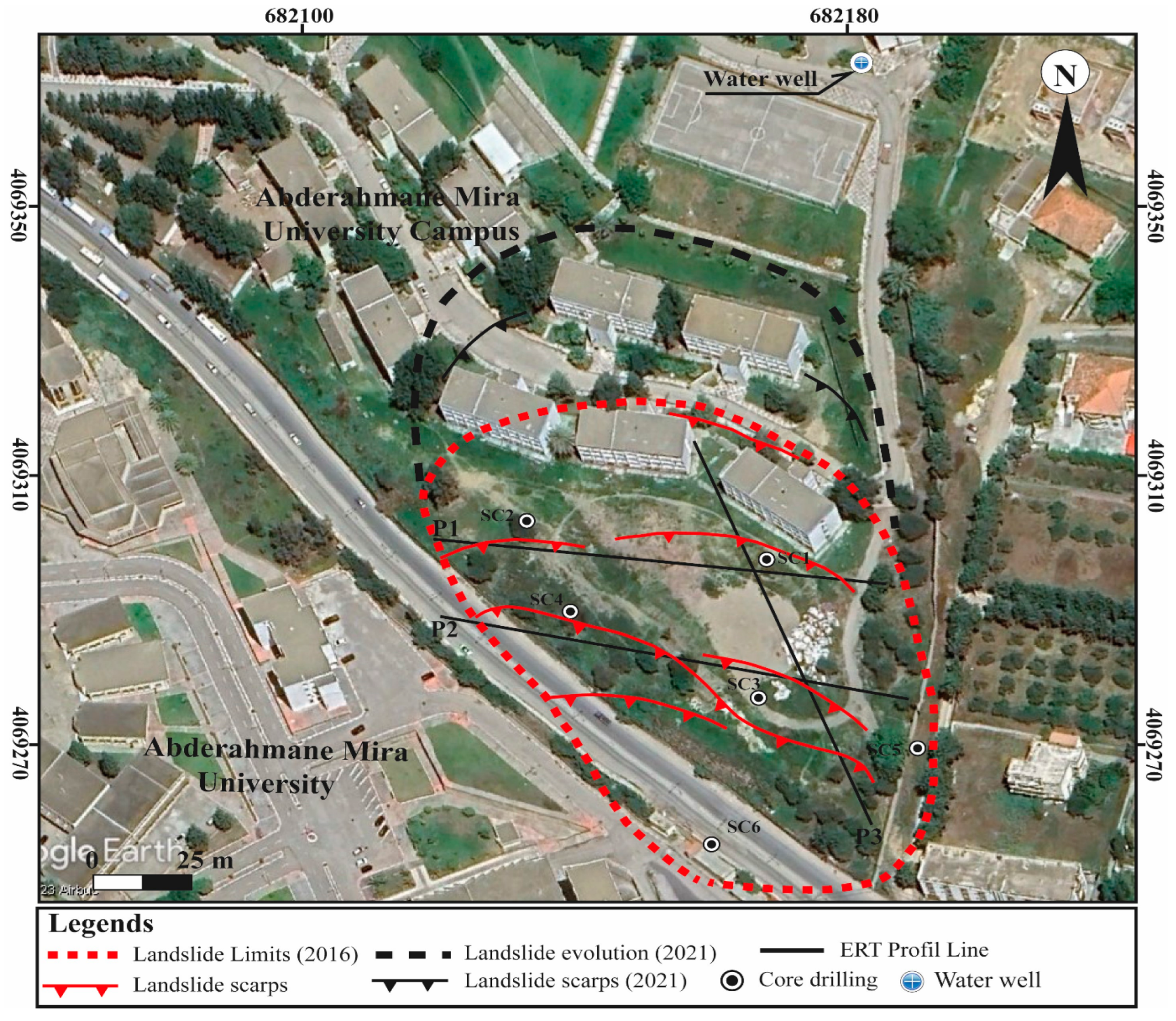
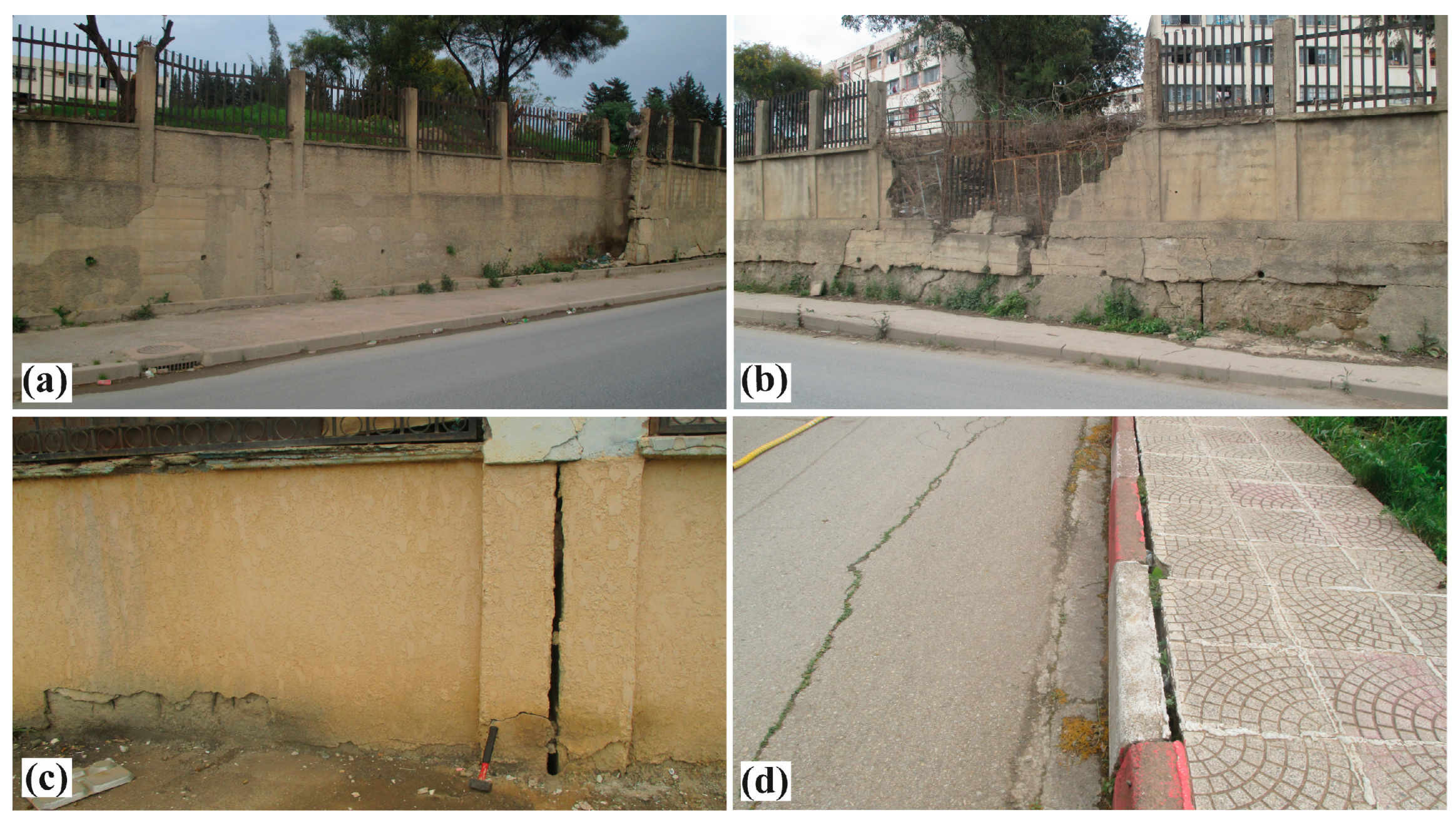
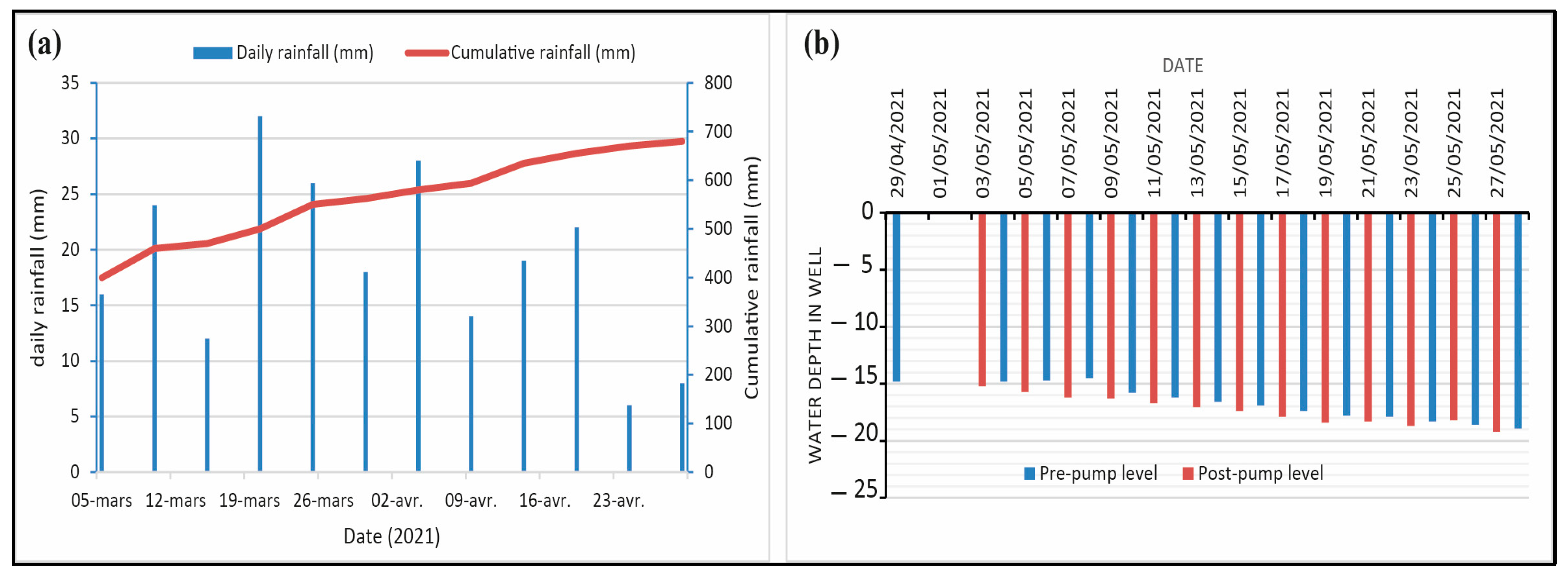

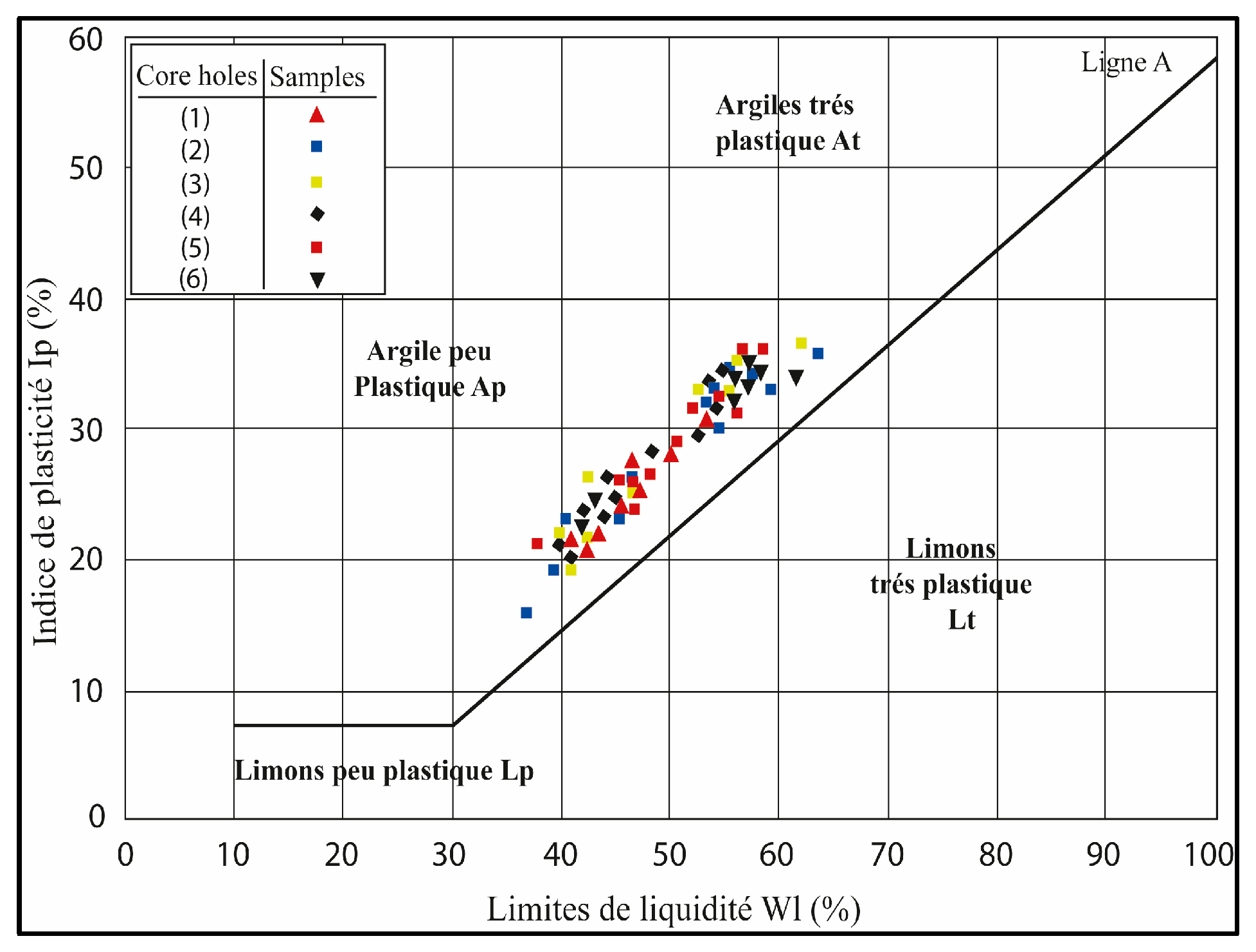

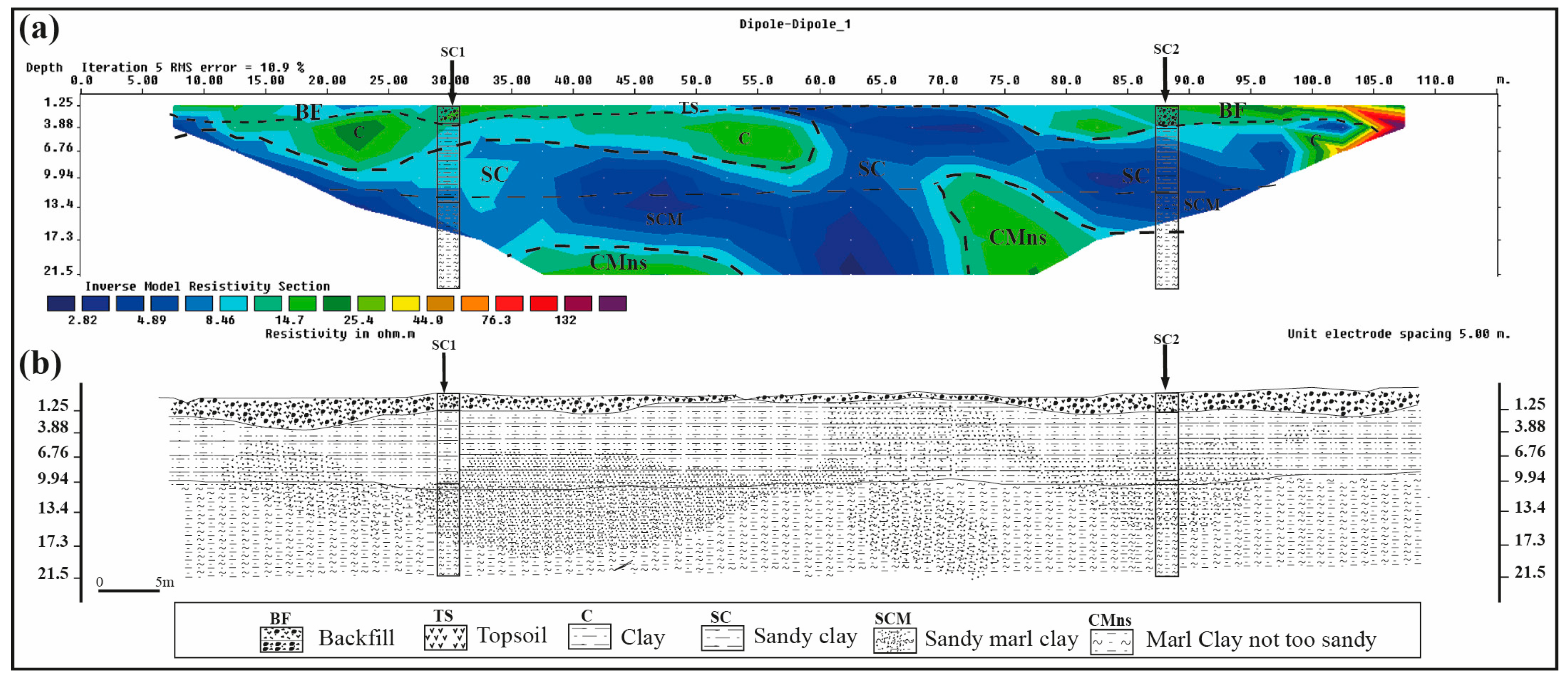
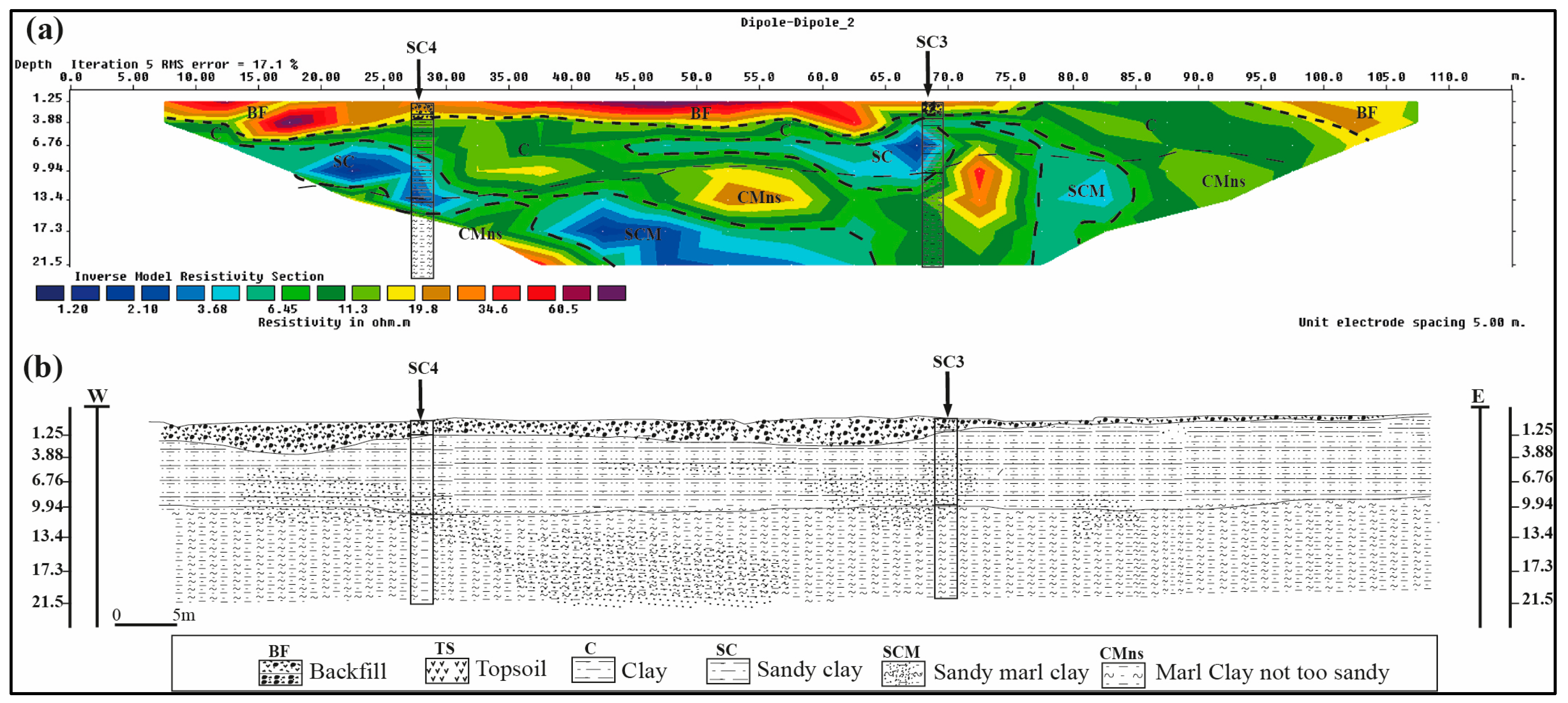


| Parameters of ERT Array | Profile Lines | ||
|---|---|---|---|
| Profile “P1” | Profile “P2” | Profile “P3” | |
| Length of profile (m) | 115 | 115 | 115 |
| Electrode spacing (m) | 5 | 5 | 5 |
| Number of electrodes | 24 | 24 | 24 |
| Type of array | Dipole–Dipole | Dipole–Dipole | Dipole–Dipole |
| Lithology | Parameters | ||||||||
|---|---|---|---|---|---|---|---|---|---|
| Wn (%) | γd (t/m3) | γh (t/m3) | Sr (%) | WL (%) | Wp (%) | Ip | Cuu (Bars) | Φuu (Deg)° | |
| Clay | 16.44 | 1.85 | 2.16 | 96.70 | 50.17 | 23.12 | 27.05 | 0.35 | 7.8 |
| Marl clay | 18.65 | 1.72 | 2.05 | 88.80 | 45,58 | 22.5 | 23.08 | 0.32 | 12.84 |
Disclaimer/Publisher’s Note: The statements, opinions and data contained in all publications are solely those of the individual author(s) and contributor(s) and not of MDPI and/or the editor(s). MDPI and/or the editor(s) disclaim responsibility for any injury to people or property resulting from any ideas, methods, instructions or products referred to in the content. |
© 2024 by the authors. Licensee MDPI, Basel, Switzerland. This article is an open access article distributed under the terms and conditions of the Creative Commons Attribution (CC BY) license (https://creativecommons.org/licenses/by/4.0/).
Share and Cite
Nassim, H.; Atmane, L.; Lamine, H.; Mouloud, H.; Anes, M. Integrated Geotechnical and Electrical Resistivity Tomography to Map the Lithological Variability Involved and Breaking Surface Evolution in Landslide Context: A Case Study of the Targa Ouzemour (Béjaia). Water 2024, 16, 682. https://doi.org/10.3390/w16050682
Nassim H, Atmane L, Lamine H, Mouloud H, Anes M. Integrated Geotechnical and Electrical Resistivity Tomography to Map the Lithological Variability Involved and Breaking Surface Evolution in Landslide Context: A Case Study of the Targa Ouzemour (Béjaia). Water. 2024; 16(5):682. https://doi.org/10.3390/w16050682
Chicago/Turabian StyleNassim, Hallal, Lamali Atmane, Hamai Lamine, Hamidatou Mouloud, and Mazari Anes. 2024. "Integrated Geotechnical and Electrical Resistivity Tomography to Map the Lithological Variability Involved and Breaking Surface Evolution in Landslide Context: A Case Study of the Targa Ouzemour (Béjaia)" Water 16, no. 5: 682. https://doi.org/10.3390/w16050682
APA StyleNassim, H., Atmane, L., Lamine, H., Mouloud, H., & Anes, M. (2024). Integrated Geotechnical and Electrical Resistivity Tomography to Map the Lithological Variability Involved and Breaking Surface Evolution in Landslide Context: A Case Study of the Targa Ouzemour (Béjaia). Water, 16(5), 682. https://doi.org/10.3390/w16050682










